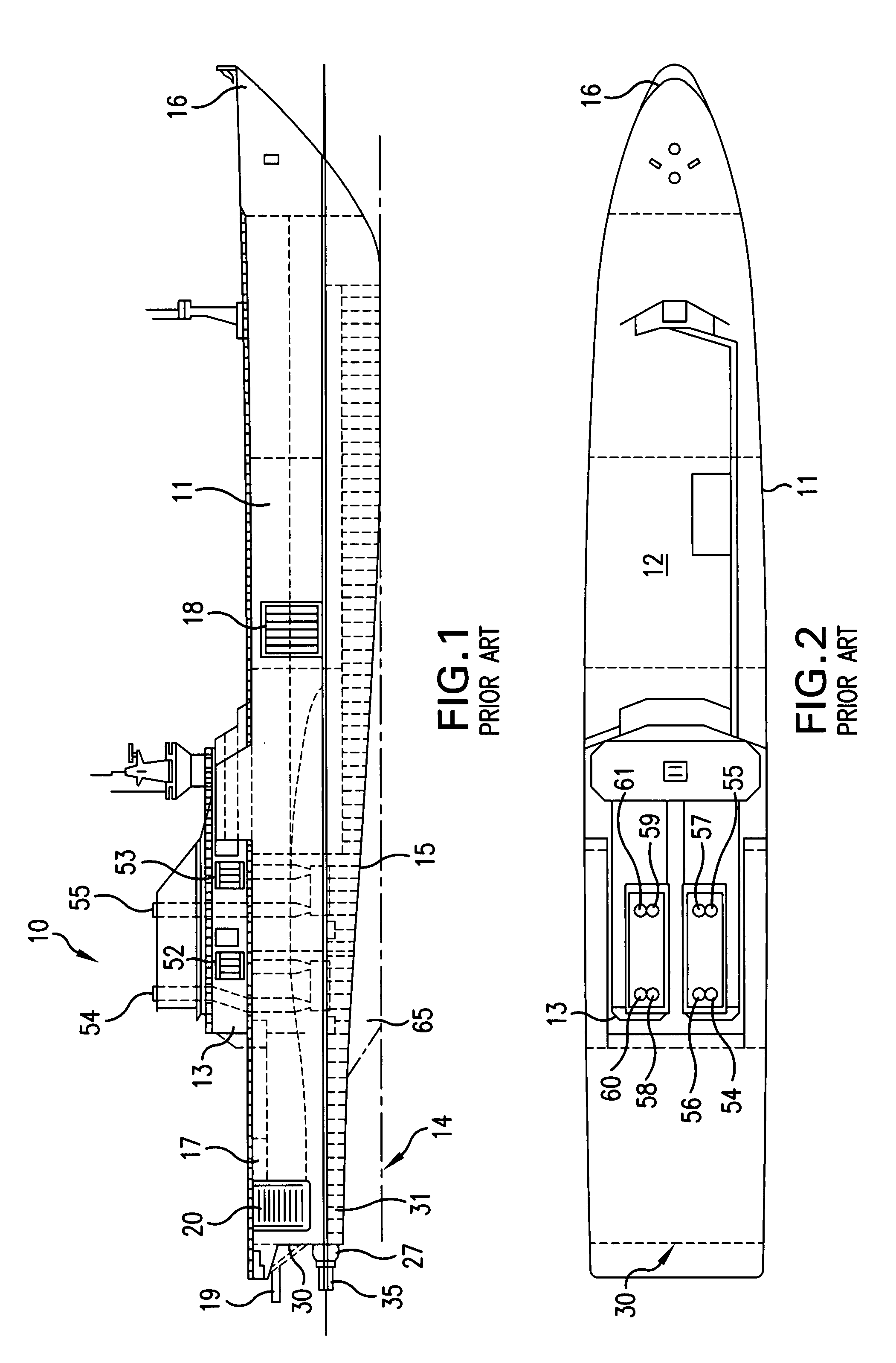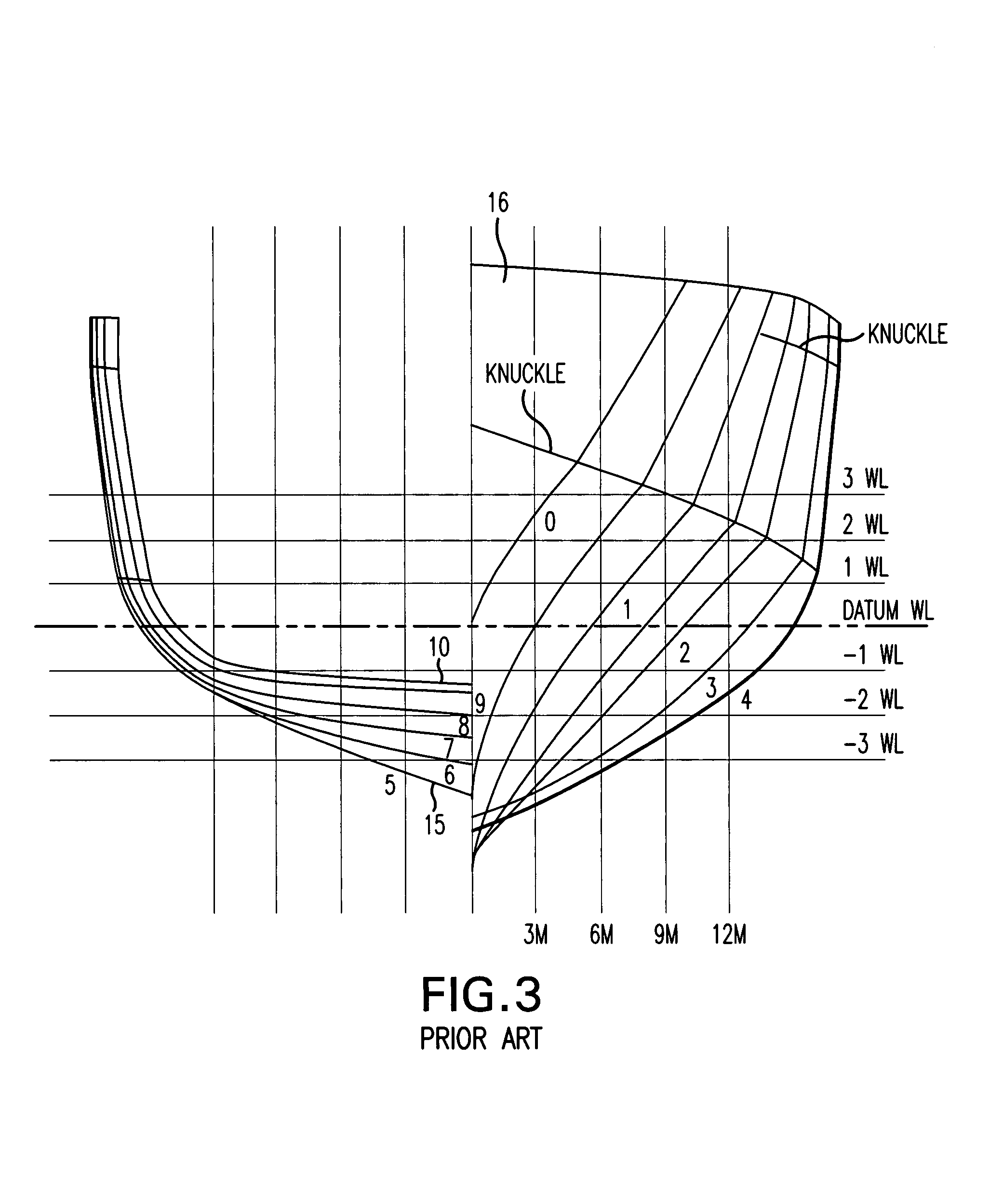Such sacrifices have to be made to achieve significantly higher performance than hitherto that current practical displacement monohull surface ship speed improvements are essentially stalled.
For example, a major limitation of
present day displacement hulls is that, for a given size (in terms of displacement or volume), their seaworthiness and stability are reduced as they are “stretched” to a greater length in order to increase maximum practical speed.
Traditional hull designs inherently limit the speed with which large cargo ships can
traverse the ocean because of the drag rise which occurs at the “threshold speed”.
In order to achieve higher operating speeds with commercial loads, it is necessary to increase ship length and size (or volume) in proportion, or to increase length while reducing width or beam, to maintain the same size and volume, but at the expense of stability.
However, new techniques can reduce the effect of this problem in ships as it has done in aircraft.
As length is increased for the same volume, however, the ship becomes narrower, stability is sacrificed, and it is subject to greater stress, resulting in a structure which must be proportionately lighter and stronger (and therefore more costly) if structural weight is not to become excessive.
Such a hull reduces the residuary resistance of the hull in water.
This is time-consuming and means that the largest ships can only undertake a relatively small number of ocean crossings per year, thus limiting the available financial turnover on their considerable
investment cost.
However, as fuel costs rise and the
average size of traditional container ships increases, the premium above sea freight tariffs required for competitive operation of the faster, but smaller ship is correspondingly increased.
However this research has previously been restricted to slow mono-hulls that operate at length Froude Numbers below the onset of substantial wave-drag; or to submarines and torpedoes when submerged below a certain depth, at which wave-drag is minimal and, due to a largely circular and constant cross-section of their
wetted area and their hulls being totally immersed, their
water flow-lines are correspondingly straight.
To date it has not been considered feasible to incorporate such technology in buoyant surface hulls above a length Froude Number of 0.30 due to the non-uniform distribution of the additive and the excessive amount of the frictional reducing additive required for significant drag reduction.
Applicant believes that this inapplicability of the
friction reducing technology to the hulls of conventional surface ships results, at least in part, because the
water flow-lines along the submerged portion of the hulls in these ships are characteristically drawn towards the
keel by the low pressure generated by their passage through the water; such low pressure and downward and, towards the
stern, upward movement of flow-lines increasing with speed, thus further reducing the effectiveness of the drag reducing method.
Another problem associated with the application of this friction drag reducing technology to a conventional hull is the effect of the drag-reducing additive upon the
propulsive efficiency of the propellers situated downstream at the back of the hull, creating
propeller cavitation leading to loss of
propulsive efficiency which can reduce the benefit of any reduction in friction drag and also drawing off the additive into the
propeller race, thus reducing its effect on the boundary layer of the aft hull.
Factors contributing to their conclusion that “the scheme is far from economically viable” were: the use of excessive amounts of additive due to an unsatisfactory ejection
system and the non-uniform water-flow, and the reduction of a maximum of only 36 percent in friction drag at length Froude Nos. of about 0.23, above which speed the effect of the additive rapidly declined, due to increasingly non-uniform flow-lines with increasing speed; and the drawing of the mixture off the aft portion of the submerged hull into the
propeller races.
To quote further from the aforementioned Dove et al. report (page 8), “One of the problems encountered during the trials has already been mentioned, namely, uneven distribution of Polyox [the
friction reducing polymer powder being applied] in the inner boundary layer.
Clearly from the measured Polyox concentrations on the hull surface, as given in Annex B, the Polyox distribution was not as efficient as originally expected.
For the reasons already given, it is impracticable to achieve a major increase in speed by the traditional method of making container ships very long because, as their length is increased for a given volume or displacement, to raise their threshold speed according to Froude's laws, their cargo
payload, beam and, hence, stability are eroded.
Serious questions also arise over the ability of propellers to deliver the necessary power due to their performance being degraded by the onset of
cavitation, their impractical size and the problems of optimizing
blade pitch at intermediate speeds, which could necessitate very complex gearboxes.
The speed is insufficient to enable the ship fully to aquaplane, or “fly”.
Yet, conversely, the speed is too high to allow proven design techniques for traditional displacement hulls to be employed.
Such techniques, necessary to reduce
frictional resistance and
delay the onset of prohibitive residuary or “wavemaking” resistance, or “wave-drag”, are in fact quite contrary to the requirements of both hull and waterjet efficiency within and beyond the defined “threshold” speed.
Lower
technical risk than a conventional hull form of similar displacement for the speed range 40 to 50 knots due to use of waterjets rather than large, complex and less efficient propeller systems.
Propellers are, however, inherently limited in size, and they also present
cavitation and vibration problems.
Moreover, diesel engines sized to produce the necessary power for higher speeds would be impractical because of weight, size, cost and fuel consumption considerations.
Due to the inherent
wide beam or low length beam ratio, and the wide transom design, there is more space available for implementing this arrangement, thus increasing the proportional limiting maximum power which can be delivered by the waterjets.
 Login to View More
Login to View More  Login to View More
Login to View More 


